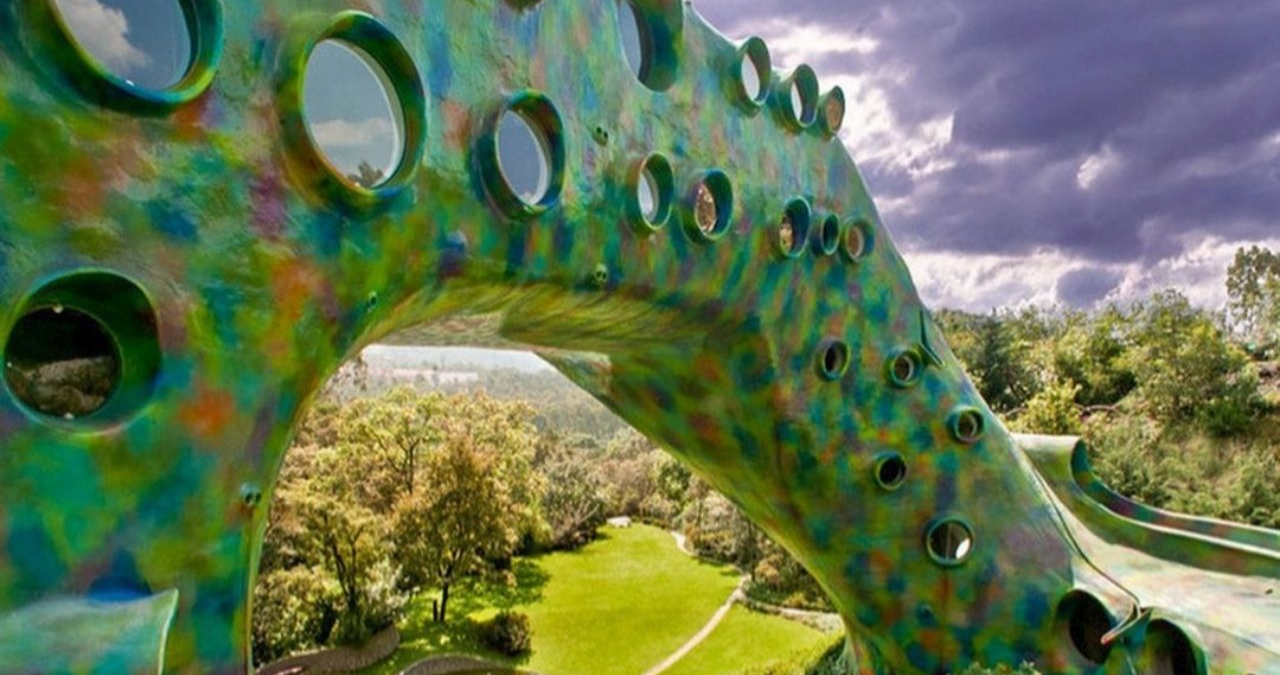The Enchanting World of El Nido de Quetzalcóatl
El Nido de Quetzalcóatl is one of the most breathtaking architectural wonders in Mexico. Hidden within the lush greenery of Naucalpan, a municipality near Mexico City, this masterpiece is a fusion of nature, art, and architecture. Created by the visionary architect Javier Senosiain, El Nido de Quetzalcóatl is not just a residence but a journey into a surreal landscape that feels like stepping into another world.
This architectural gem is named after Quetzalcóatl, the feathered serpent deity from Mesoamerican mythology, and its design draws direct inspiration from the serpent’s sinuous form. The organic curves, colorful mosaic tiles, and integration with the natural surroundings make it a living piece of art. Unlike conventional buildings, El Nido de Quetzalcóatl blends seamlessly into the environment, making it one of the most remarkable examples of organic architecture in the world.
The Vision Behind the Creation
Javier Senosiain, a renowned Mexican architect, is known for his love of organic architecture, which seeks harmony between human living spaces and nature. His inspiration for El Nido de Quetzalcóatl came from his fascination with pre-Hispanic culture and the natural world. The concept was to create a dwelling that does not disrupt the landscape but rather becomes a part of it.
The project began in the early 2000s when Senosiain discovered a plot of land with caves, hills, and a natural ravine. Instead of altering the terrain to fit a conventional structure, he designed a home that embraced the land’s natural contours. The result was a mesmerizing serpent-like structure that slithers through the greenery, creating an immersive experience for its inhabitants.
Architectural Design and Inspiration
El Nido de Quetzalcóatl is a masterpiece of organic architecture, where every element flows naturally into the next. The entire structure resembles a massive snake, with its head, body, and tail forming a harmonious dwelling that is both functional and artistic. The serpent’s body is divided into interconnected living spaces, with tunnels and bridges linking various areas.
The design incorporates a series of arches, curving walls, and stained-glass windows that filter light beautifully into the interiors. The exteriors are adorned with mosaic tiles in shades of blue, green, and gold, creating a shimmering effect that enhances the serpent motif. The use of local materials, such as volcanic stone and concrete, ensures that the structure remains in harmony with its environment.
The Integration with Nature
One of the most captivating aspects of El Nido de Quetzalcóatl is its seamless integration with the surrounding landscape. Instead of cutting down trees or flattening the land, the structure was built around the natural elements. Gardens, water features, and pathways are designed to complement the existing ecosystem rather than disrupt it.
The result is a living space that feels like an extension of the forest. Birds, butterflies, and other wildlife freely move through the gardens, making the experience even more magical. The use of natural light, ventilation, and eco-friendly materials further enhances the sustainability of the project.
The Symbolism of Quetzalcóatl in the Design
The name and form of El Nido de Quetzalcóatl are deeply rooted in Mexican mythology. Quetzalcóatl, the feathered serpent, is one of the most significant deities in Mesoamerican culture, representing wisdom, wind, and fertility. The undulating structure of the building mirrors the fluid motion of a serpent, reinforcing its connection to this powerful symbol.
In ancient times, Quetzalcóatl was believed to bring knowledge and civilization to humanity. By incorporating this symbolism into the architecture, Senosiain not only pays homage to Mexico’s cultural heritage but also creates a space that inspires creativity and reflection. The flowing design, vibrant colors, and natural integration all reflect the harmony that the feathered serpent represents.
Exploring the Interiors
The interior spaces of El Nido de Quetzalcóatl are just as captivating as the exterior. Each room follows the organic curves of the structure, avoiding straight lines and sharp angles. The walls and ceilings are adorned with artistic patterns, and the natural light filtering through stained-glass windows creates a kaleidoscope of colors inside.
The layout includes residential spaces, work areas, and communal zones, all designed to encourage a connection with nature. Open courtyards, large windows, and skylights ensure that every room feels bright and airy. Even the furniture is designed to complement the curved aesthetic, with custom-built pieces that fit seamlessly into the environment.
The Experience of Staying in El Nido de Quetzalcóatl
While El Nido de Quetzalcóatl was initially a private residence, it has since become an attraction for architecture enthusiasts and travelers. Some parts of the property are available for rent, offering visitors a chance to immerse themselves in this extraordinary setting. Staying in this organic masterpiece is a truly unique experience, blending comfort with an otherworldly ambiance.
Guests can explore the gardens, relax in the tranquil courtyards, and take in the breathtaking views from various vantage points. The atmosphere is peaceful and meditative, making it an ideal retreat for those looking to disconnect from the hustle of city life and reconnect with nature.
The Influence of El Nido de Quetzalcóatl on Modern Architecture
El Nido de Quetzalcóatl is not just a singular marvel but a significant influence on contemporary architecture. Its design challenges conventional notions of space, structure, and sustainability. Architects worldwide have taken inspiration from its organic forms, emphasizing the importance of blending buildings with their natural surroundings.
The project also highlights the value of preserving cultural heritage through architecture. By drawing from Mesoamerican mythology and natural landscapes, Senosiain has created a timeless work that speaks to both history and innovation. Future architects are increasingly exploring similar concepts, creating eco-friendly and culturally significant structures that push the boundaries of design.
The Future of Organic Architecture
As climate change and urbanization continue to impact the world, the principles behind El Nido de Quetzalcóatl are becoming increasingly relevant. The integration of sustainable materials, energy-efficient designs, and harmony with nature is now a priority in modern architecture.
Organic architecture is gaining traction as a response to environmental concerns, offering an alternative to conventional, resource-heavy construction methods. More architects are experimenting with fluid forms, biomimicry, and green building techniques to create spaces that not only look stunning but also minimize ecological impact.
A Legacy of Creativity and Sustainability
El Nido de Quetzalcóatl stands as a testament to the power of visionary design. It embodies a perfect balance between art, architecture, and nature, demonstrating how built environments can exist in harmony with their surroundings. As more people seek sustainable and innovative living spaces, this masterpiece serves as an inspiration for future generations.
Its legacy extends beyond its walls, influencing architects, designers, and environmentalists worldwide. The principles it represents—cultural respect, ecological sensitivity, and artistic freedom—are more relevant than ever. In a world increasingly dominated by rigid urban landscapes, El Nido de Quetzalcóatl reminds us that architecture can still be magical, fluid, and deeply connected to the earth.

